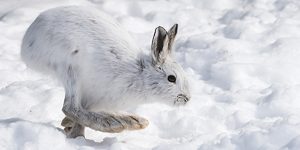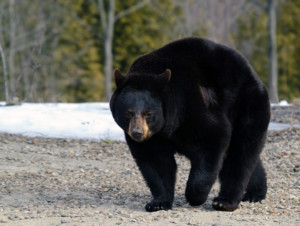With the winter solstice approaching and the holiday season in full swing, what’s your go-to way of staying cozy and warm? Throw another log on the fire? Pull out your favorite sweater for an extra layer? Or perhaps, you’re in the kitchen cooking up a hearty stew?
As humans, we have many ways that we can keep out the cold by altering our environment. But of course for our Pennsylvania wildlife, adjusting the thermostat is not an option. Fortunately, they have a variety of amazing physical and behavioral adaptations to help them survive the winter.
Here’s a look at a few of those wintertime adaptations!

Lepus americanus
Photo credit: The National Wildlife Foundation
A New Coat
Some mammals, such as the snowshoe hare and ermine, change color to help camouflage themselves and elude predators. In the fall, as the days become shorter, they’ll start to molt their brown fur and instead don a white coat to match the snow just in time for winter.
The white-tailed deer’s coat changes from a reddish-brown to a dark, grayish-brown in the winter months. The winter coat consists of long, thick, hollow guard over wooly, densely packed underfur. That design locks in the deer’s body heat and provides insulation capable of holding snow on the animal’s back without melting.
Hibernate
While you might be quick to assume that all bears hibernate, it’s actually a common misconception! Only a few Pennsylvania mammals are true metabolic hibernators, meaning their respiration and heartbeat slow dramatically, and body temperature falls to near freezing. These include the woodchuck, the 2 jumping mouse species and all 11 bats common to the state.
Torpor
Black bears, common in PA, fall into this winter survival strategy category. Torpor occurs when an animal lowers its heart and respiratory rate down to a point that saves energy, but is not the near death of hibernation. Animals in torpor are capable of being aroused and/or waking occasionally to move about and eat. Other common animals in PA that have extended periods of torpor include chipmunks, skunks, and raccoons.

Photo credit: Outdoornews.com

Photo credit: www.vernalpools.me
Frozen Alive
Several species of frogs, including the common Wood Frog, are freeze tolerant, meaning capable of surviving episodes of freezing. They’ll remain frozen under leaf litter or rotting logs throughout the winter, until their anti-freeze like blood helps them defrost. They’ll be the first amphibians to congregate in vernal pools for mating in the spring.
Teamwork
Many animals find warmth in numbers throughout the winter. Snakes usually move from a summer habitat to a winter den in caverns or crevices of rock formations. In fact, many different species of snakes may even den together.
Honeybees really prove that they are the ultimate workers in the winter. To insulate the colony as outside temperatures drop, the honey bee workers form a cluster around the queen and the brood (immature bees, from eggs to larvae) to keep them warm. As the temperatures drop, the worker bees will generate heat by flexing the flight muscles located within the thorax of their bodies, keeping the inside of the cluster at a cozy 90 degrees. Bees on the outside of the cluster trade places with those at the center to maintain the cluster temperature, and feed on stored honey in the hive throughout the winter.

Photo credit: beewellhoneyfarm.com
Happy Winter Solstice everyone! Don’t let the cold weather stop you from enjoying the beautiful Pennsylvania wilds this winter….and be thankful you’re not a wood frog! 🙂

